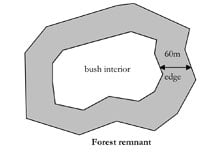Many patches of bush today are small in size, with plants growing on the edge exposed to higher levels of sunlight, greater fluctuations in temperature and lower levels of humidity than those growing in the more sheltered bush interior. These conditions limit the range of plants for up to 60 m in the bush, creating an ‘edge effect’.

Diagram demonstrating edge effect
The diagram on the right demonstrates ‘edge effect’ and exposure to elements of plants near edge.
Plants growing on the bush edge have increased exposure to:
- light
- wind
- heat
- cold
- weeds
In small bush fragments without a shaded interior, a fully representative range of plants (as found in much larger forests) may be absent.
Some trees like kahikatea can cope with more open conditions and many small stands survive today. When protected from stock, kahikatea stands provide ideal growing conditions for many other native forest plants.
From Protecting natural areas - a design guide:
Maximise the core and minimise the edge
It can be more ecologically valuable to have one large protected area than several smaller patches of the same total area. The core area should be large enough to adequately sustain the ecosystems present. A large core will enable continual self-generation and allow for the evolution of indigenous communities in the long term, including ecotones. If the protected area is too small, there will be no ‘critical mass’ to sustain complete ecosystems.
The size and shape of a protected area can have a large bearing on the ecological success of the protection. If the protected area is too small it could have a very limited opportunity to exchange genetic material. Edge effects may pervade so that the ecosystem will gradually change and lose its integrity.
An abrupt and artificial change at the boundary to a protected area, such as between pasture and natural ecosystems, is the place of greatest stress on the natural system through climatic exposure, pressure from animal browse, and pest encroachment. Thus a minimal length of edge, or low perimeter to core area ratio, is usually desirable. A compact shape, with minimal unprotected enclaves, is better than an elongated one, to reduce the ‘edge effect’.
However, in high fire risk areas the fire risk can be greater in one large protected area rather than several smaller protected areas with firebreaks between.